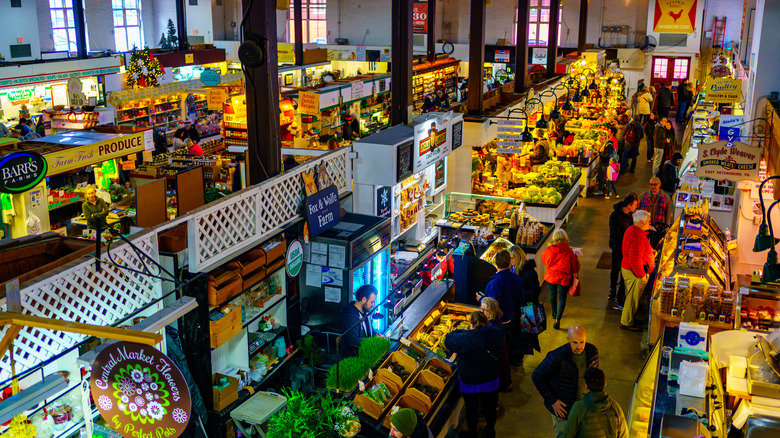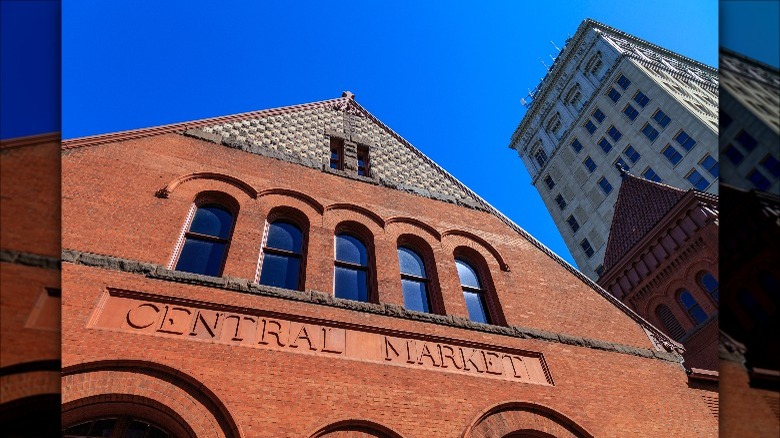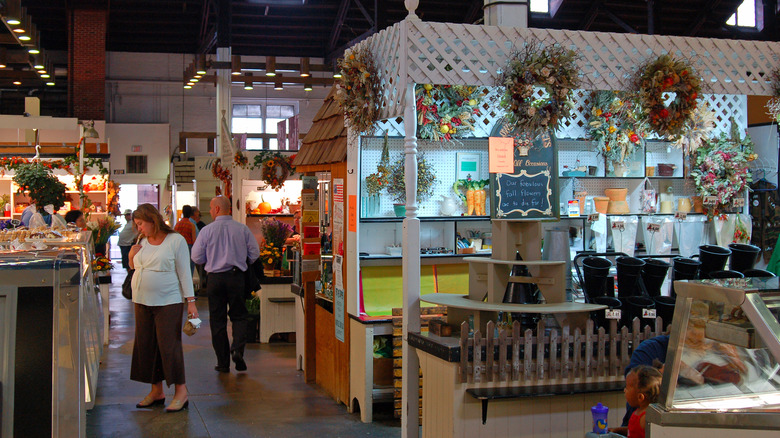America's Oldest Farmers' Market Dates Back To The 18th Century
Located in downtown Lancaster, Pennsylvania, the Lancaster Central Market is housed in one of the city's historic buildings. Built in 1889, the edifice stands as a testament to the market's staying power in the city. However, while this historic farmers' market has only been at its North Market Street location for 135 years, the market itself has existed longer than that.
Visitors typically come to the market to stock up on locally sourced food. It's also a spot where members of the public can celebrate important events, like the Strawberry Festival in June, a Harvest Breakfast in the slightly chilly days of October, and naturally, the festive spirit of the Season of Light. As people wander in and out of the vendors' stalls, they're met with an assortment of edible goods and other gifts to make these events all the merrier.
Of course, the city's residents don't need to wait for the holidays to roll around for an excuse to visit the market. Between all the specialty cheeses, sweet scoops of ice cream, fresh baked goods, and locally grown produce, plus the abundant fish and meat offerings, they have plenty of reasons to stop by. In short, with its 20,000 square feet of floor space and 13 sets of double doors, this red building constructed in the Romanesque Revival style offers refuge to those who see it as more than just a place to shop from the market's 60 or so vendors. It's nothing short of Lancaster's vibrant heart.
It's older than the Declaration of Independence
In 1730, some 46 years before the Declaration of Independence of the United States came into existence, a 120-foot piece of land became the country's first (and now longest continuously-running farmers' market). The plot of land for the market was set aside on the private property of Andrew and Ann Hamilton and was to be a gathering place for local farmers to bring their homegrown foodstuffs.
The establishment of the Lancaster Central Market played — and still plays — a big role in supporting the philosophy that farmland is fundamental to cultivating community in Lancaster, Pennsylvania. Even England's reigning monarch at the time, King George II, threw his support behind the market and its ideals. In 1742, he decreed that the market should be open for business two days a week. Today, the local catchphrase "Meet me at the market" still epitomizes that spirit. Modern market organizers have even added a third day to the market's schedule. The Lancaster Central Market vendors now mingle with the public on Tuesdays, Fridays, and Saturdays from 6 a.m. until 3 p.m. They do shutter their stalls on holidays, however.
In 1972, the Lancaster Central Market earned a place on the National Register of Historic Places. It's now under the stewardship of the Central Market Trust, which a group of representatives from the City of Lancaster, standholders, and volunteers from the public established in 2005.
The character of the market has changed
Currently, the Lancaster Central Market faces a bit of an identity crisis. Originally, the organizers of the market established it as a place where local farmers could sell their wares, and the community could celebrate the abundance of farmland in the region. Nearly 93,000 acres of suburban sprawl has replaced area farmland since the late 1950s, threatening the market's original intent. Along with the houses that come with such developments, large grocery store chains have taken up in the city's retail spaces, further putting the health of the market at risk.
Like all relevant food stories, a walk through the vendors' stalls reveals the market's changing character. Whereas it used to be that the primary goods sold at the market consisted largely of fresh and locally produced fruits and veggies, fish, meats, and all kinds of eggs, that isn't the case today. Visitors are now as likely to run into vendors who sell candy, flowers, and handmade gifts and not the fresh wares that the market was founded upon.


